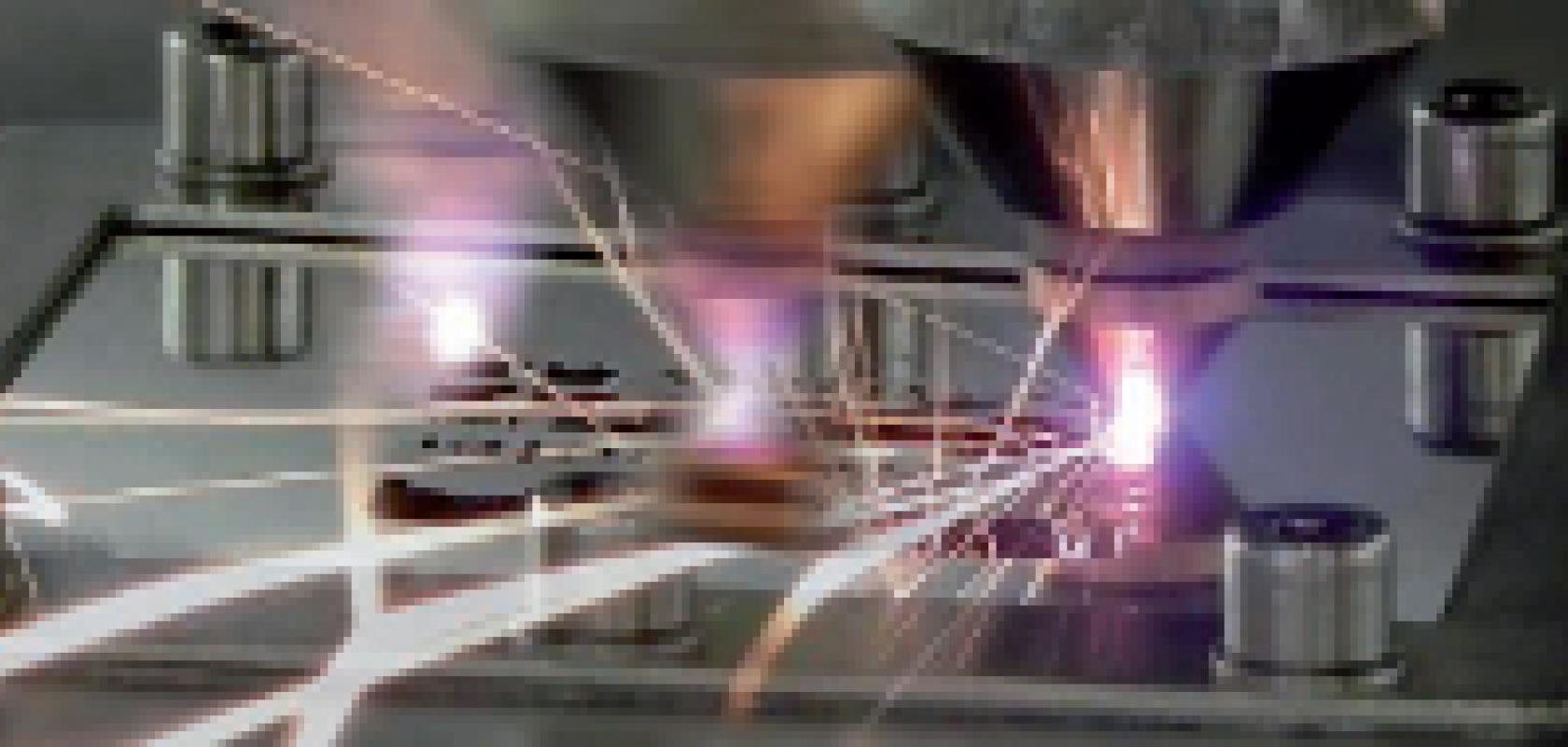The European Commission is careful where it puts its money when it comes to science and technology funding, but €17m was put aside in October 2009 to fund the LIFT project. The four-year
programme aims to keep European industry at the forefront of both fibre laser development and usage, and covers the whole fibre laser value chain from diodes, to gain fibres, to MOPAs, transmission fibres, and scanners.
Tom Pearsall, director of the European Photonics Industry Consortium, is one of the partners of the project and is responsible for raising awareness of the project throughout industry. He explains that the project is looking to cater for four main application areas: medical and healthcare, photovoltaics for renewable energy, manufacturing of the next generation of integrated circuits with nanometre-sized features, and other laser material processing applications at both high and low powers.
The project, he says, is very deliverable-focused, both from the point of view of the European Commission’s Seventh Framework Programme providing the funding, and from the point of view of the partner companies involved. Rofin, for example, is counting on coming out of the project with a product it can sell, but funding depends on meeting key requirements in terms of deliverables. ‘It’s a case of “If you don’t make the grade, you don’t get paid”’, explains Pearsall. Each company therefore not only has specific project goals, but financially-driven requirements.
Andreas Oehler is project leader at Time Bandwidth Products, one of the partner companies given the task, among others, of developing a femtosecond pulsed fibre laser source for micromachining applications. He explains why the European Commission funded the project: ‘A lot of EU companies are world-leading manufacturers of industrial laser technology, and Europe has an interest in keeping this standard rather than letting US or Chinese competitors take over. Additionally, fibre lasers are something of a hot topic at the moment, as they have many advantages over other laser technologies.’ These advantages, he acknowledges, do not extend to all aspects of the technology, but one of the goals of the LIFT project is to improve the boundaries of fibre lasers so as to make them an even more attractive option – especially in applications that may not have used laser technology in the past.
Fibres
Fibre lasers are based around a doped gain medium. ‘The fibre is the key to the whole amplification system, but they are prone to optical damage,’ says EPIC’s Pearsall. He cites the challenge of photodarkening as being one of areas in which the project has produced breakthroughs. In high power fibre lasers, the gain fibre can degrade over time, growing dark and losing output power. A typical high power fibre laser in an industrial application can be expected to be switched on for at least 364 days a year and so any photodarkening would lead to unacceptable downtimes.
Several project partners have been working on photonic crystal fibre (PCF) gain media in order to address this problem. ‘A PCF allows us to construct a fibre with a large mode area and still have it emit single-mode light. The whole challenge is getting power into a fibre without it turning black, and a wider mode area facilitates this,’ says Pearsall.
Andrew Robertson from Gooch and Housego adds that delivery fibres are just as important as amplification fibres: ‘We have been working with the other partners to get the right fibres and materials, cladding and design. The fibres are more complicated than many people realise, and we need manufacturers to consider this; it’s not just a basic pipe for light.
‘The key point in terms of what we’re delivering is high power visible wavelength fibre lasers’ says Gooch and Housego’s Robertson. ‘This means that the lasers have to be polarisation maintaining, and in order to get to the visible wavelengths we have to use non-linear optics.’ Among the components Gooch and Housego is supplying are the latest generation of high power polarisation-maintaining fused-fibre products. ‘This part of the project is about splitting wavelengths, monitoring power with a tap coupler, or combining wavelengths and polarisation.’
A visible difference
‘In general, for fibre lasers to actually achieve more general market penetration, they’re going to need to be able to do non-linear optics,’ says Robertson, adding that this will allow them to produce the visible wavelengths required in healthcare and biophotonic applications. Polarisation-maintaining lasers are a requirement of this, he explains, but they are currently prohibitively expensive.
David Pureur, director of Quantel, adds that alongside visible wavelengths, obtaining a single mode output is also important for the company’s predominantly medical applications. ‘Single mode technology ensures that your lasers will reach a very small spot size on your target, associated with a long Rayleigh length. For some medical applications, it is very useful to focus the laser beam to a very small spot size (the area you want to treat) to avoid any collateral damage. Human tissues are highly sensitive to laser light, but many laser treatments require high-output power in the visible wavelength range, mainly for achieving the photocoagulation process.’
Diodes
The other key components of fibre lasers that the project is looking to improve are the pump diodes. ‘If you look at the bill of materials in a fibre laser, the diodes will be one of the most significant costs,’ says Joerg Neukum, director of sales and marketing at Dilas. ‘High brightness, fibre-coupled pump sources are our business, as well as direct diode lasers, and so we already had many of the developments the LIFT project was looking for on our technology roadmap. When it came to the LIFT project we were asked to participate mainly because we already had some of the required components, and some of the other partners were already using those components as pump sources.’
One of Dilas’ products for the project is already used inside Rofin’s lasers – a 135W 976nm 200µm conduction-cooled minibar stack. ‘This offers the advantages of both a laser bar and a single emitter in a very low fill factor bar,’ explains Neukum.
‘The company has introduced significant automation into its production line in order to obtain fully-automated assembly. This brings the cost down, but chip costs and associated micro-optics costs are still the major drivers of fibre laser cost.’
Other considerations
Pearsall notes that approximately 75 per cent of the market for fibre lasers in high power materials processing is taken by IPG. ‘IPG has important facilities in Europe for the design and manufacture of pump laser diodes,’ he says, adding that although the company is US-based, it is by no means a non-EU organisation. ‘Their success is a benchmark for everyone else in the fibre laser business; they got there by being first to deploy industrial-grade fibre lasers. Their technology is very good, and they are aggressive in marketing.’
Robin Bell of SPI, another partner in the project, notes that although the UK-based company is in the same high-power fibre laser market as IPG, it aims to differentiate its product offering to go after a different clientele, namely one that doesn’t mind paying more for a laser with more features. That doesn’t prevent the company from aiming for more of IPG’s market share, however: ‘We’re definitely trying to compete, but we’re going after a slightly different niche,’ says Bell. ‘We’re currently a strong second in the high power fibre laser market, and as long as we keep an eye on the developments of those behind us in the race, we believe we can keep doing very well. It’s a long way to that number one spot, but that’s where we are aiming!’
While Pearsall acknowledges that nothing within the LIFT project will unseat IPG from its high power materials processing throne, he adds that this is not really the goal of the project. ‘The key aim is to produce fibre laser research that is capable of opening up new markets, away from that of the high power fibre lasers for materials processing. Traditional manufacturing areas grow at a fairly modest two to three per cent per year, but that represents a huge opportunity for fibre lasers if we could get them into some of those applications.
‘Part of this will be about demonstrating that fibre lasers offer enough process control to address the very specific needs of European small scale manufacture – the Swiss watch-making industry being a very good example. In that industry, each laser system provides the whole manufacturing chain for each watchmaker.’
The LIFT project is also working on various other principles common to other pieces of manufacturing equipment, such as reducing size in order to make the systems more effective as tools. In a world concerned with energy usage, increasing efficiency is also very important.
Another important advantage of fibre lasers over other technologies, at least as far as accessibility into new applications is concerned, is that they are electrically addressable, and so integration with computer control is particularly easy to achieve. The high beam quality of a fibre laser also allows the beam to be scanned easily and quickly using galvo scanners, again facilitating computer control.
Scanning
Tero Kumpulainen, a researcher at the Tampere University of Technology, Finland, has been working as part of the LIFT project to improve the accuracy of galvo scanners through new calibration techniques. ‘Applications for the laser scanners are becoming more demanding. We need very high accuracy, but also very high speed.’ Kumpulainen’s research centres on a series of calibration shapes, which the scanning head traces out, and which can then be checked in order to analyse scanner dynamics. ‘We look at how they perform at right angles, or when producing circles, for example,’ he says. Although relatively simple, this is a new approach, and one which will allow the other partner companies in the project to achieve scanning speeds of many metres per second.
A tough task
The €17m project is coordinated by Udo Klotzbach of the Fraunhofer IWS in Dresden. His job involves keeping companies that would otherwise be competing with each other at arm’s length from each other, while coordinating the work they carry out so as to produce a cohesive and useful final effort. Furthermore, EPIC’s Pearsall handles and develops the exploitation of any IP generated by the project, although it ultimately belongs to the partners of the project.
Two competitors working under the common banner of LIFT are Oclaro and Dilas, both developing pump diodes. Dilas’ Neukum notes that for certain work packages, he has been obliged to disclose some details of what his company does, but these disclosures have not been too frequent, and have not been too intrusive. Quantel is in a similar situation: ‘We have competitors in the consortium,’ says Pureur, ‘but each is developing laser products for its own targeted applications. This project is very also collaborative, with optical components developed and tested by many partners, and some of the fundamental aspects shared between us.’ Good management, it seems, keeps the atmosphere at meetings well-natured.
Finally, Time Bandwidth’s Oehler sums up the importance and the aims of the LIFT project well: ‘The general parameters for sources we develop here have to be outstanding, or at least state of the art. It’s seen as very important for Europe to keep ahead in terms of research and development, not just because fibre lasers are fashionable, but because they have a lot of advantages. It is important to push the limits of what is currently feasible, and also to develop new fibre lasers that go beyond the limits of where we are today.’


